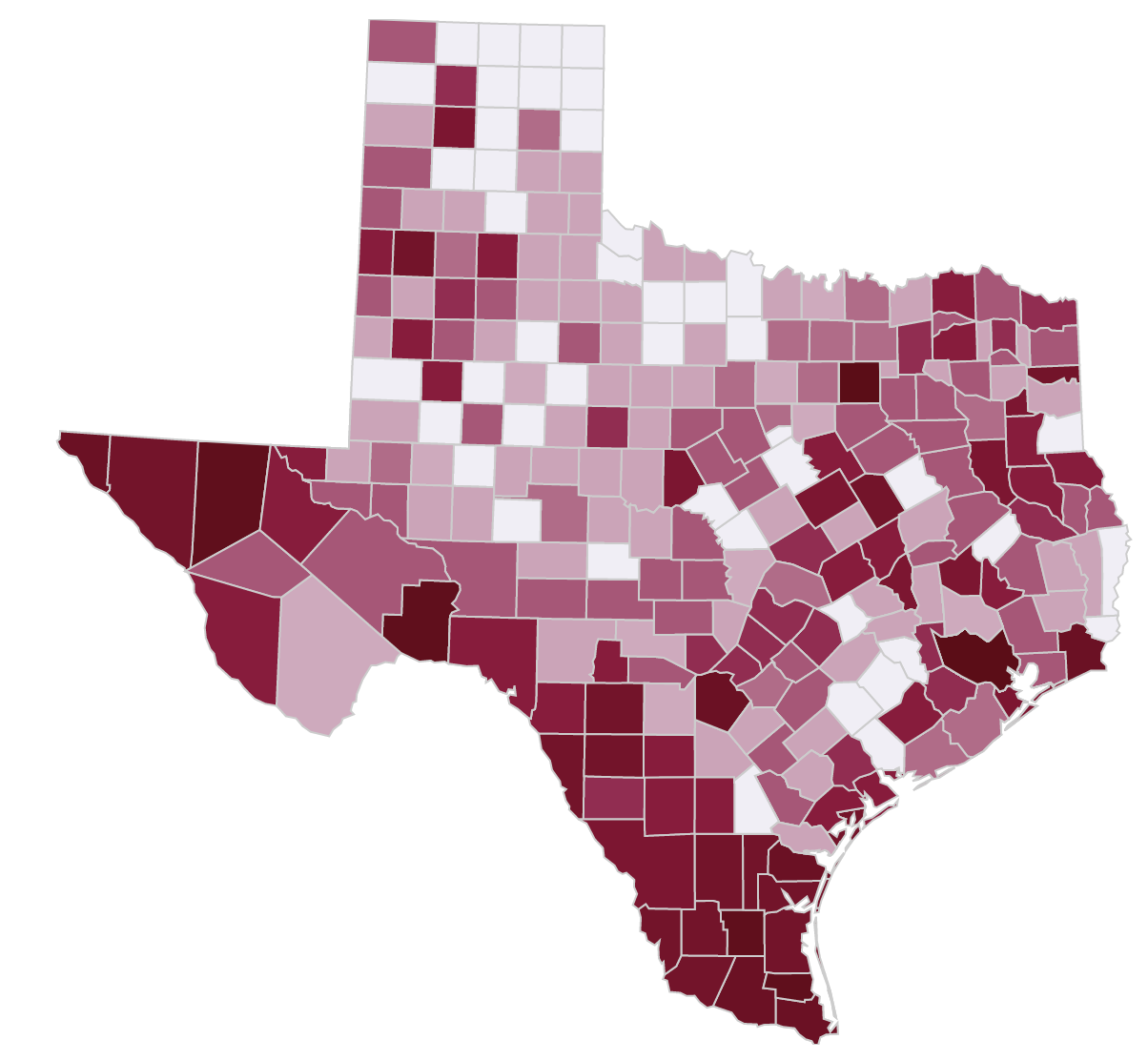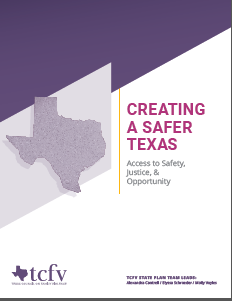
“I decide what I want. They just put me all of the options and I decide what I want at the end.”
Welcome to the Texas State Plan!
Together with advocates, survivors, funders, and our partners in the research community, the Texas Council on Family Violence (TCFV) offers the 2019 Texas State Plan, entitled Creating A Safer Texas: Access to Safety, Justice, and Opportunity.
The goal of the 2019 Texas State Plan is to create a detailed inventory of available family violence services in the state, as well as identify gaps in availability of service, and emerging issues with a focus on the self-identified needs of survivors.
Learn more about this website and how you can use it!

The 2019 Texas State Plan
The research, conducted by the University of Teas at Austin (UT Austin) and the Texas Council on Family Violence (TCFV), included surveying leaders of family violence programs, interviews with both survivors and front-line family violence program staff, and analysis of existing data on family violence from a variety of sources. Research questions included
- What services are available, and truly accessible, to survivors of family violence in each of Texas’ 254 counties?
- Where are the gaps in services, supports, and availability of resources to survivors of family violence in Texas counties?
- How do demographic, community factors, and system interventions influence responses to family violence?
The 2019 State Plan is a collaborative effort to create a shared vision of a state where all survivors of family violence have access to support and resources they need. The plan is an evidence-based blueprint for fund distribution from the Health and Human Service Commission Family Violence Program (HHSC FVP), a key distributor of funds to support family violence programs, and the Family Violence Prevention and Services Act (FVPSA) which serves as a dedicated federal funding stream for family violence shelters. With the voice of survivors at the forefront of the research, the State Plan seeks to create interventions that are survivor-defined.
There are a variety of Texas State Plan findings throughout this interactive website, including county specific data, survivor experiences within different systems, full research reports, and access to additional data for export.
Survivors Who Never Accessed Services
Research has consistently shown that only 10-25% of survivors of family violence will ever access services1. This indicates a growing need for any State Plan efforts to seek to understand the experience of a survivor who chose not to utilize family violence services, or who encountered barriers in doing so. As an expansion of prior State Plan efforts, TCFV added this component to the 2019 State Plan and worked with researchers from across the state to engage the voices of survivors who had interacted with related systems who had never sought service. Those interviewed included victims of dating violence as youth, immigrant survivors of domestic violence, as well as service providers supporting immigrant survivors, and survivors of family violence who accessed health care.
1 Langton, L., & Truman, J. L. (2014). Socio-emotional impact of violent crime. US Department of Justice, Office of Justice Programs, Bureau of Justice Statistics.
Traditionally-Underserved Communities
“But the barrier is that the Executive Board does not look like me nor the community in which it serves.”
– Underserved Community Stakeholder Group Participant
The 2019 State Plan acknowledges that survivors’ lives are multi-dimensional and that their strengths, and barriers, are unique. Survivors from communities that have traditionally experienced marginalization or historical systemic oppression face barriers to accessing services. Systemic interventions like calling law enforcement may not be as readily accessible or they may face disproportional, adverse responses, such as in the child protective services system. In order to create the safer Texas we envision, we must seek to understand where these barriers–and strengths–exist, and engage in an honest assessment of where services are not meeting the needs of survivors or whether additional barriers are present.
To accomplish this, TCFV held spotlight calls and in-person listening projects, and then contracted with an additional research team to do an analysis of these sessions. The communities of people highlighted in this report were identified in the last Texas State Plan (survivors with mental health concerns, culturally-specific communities, LGBTQ communities, survivors from rural areas) with the addition of human trafficking survivors.
Background and History
In 2002, the original State Plan was created to meet Federal Family Violence Prevention and Services Act requirements as well as new directives in the Texas Human Resource Code to have a “Family Violence Services Plan”. The original State Plan contained both a description of the need for services, as well as detailed charts on the availability of services. In 2007, in close coordination with HHSC, TCFV updated the State Plan, adding new maps and service charts.
Five years later, in 2012, TCFV embarked again on a process to update the State Plan and re-envisioned the ways in which it assesses and summarizes access. In this iteration, published in 2013, TCFV worked with partners to look at all access points through the eyes of a survivor of family violence and sought to answer questions, such as:
- Where could a survivor access services?
- How would a survivor know where to go?
- What additional supports are in place within family violence programs?
To answer these questions and apply this survivor-centered focus, TCFV engaged in a collaborative effort with the Steve Hicks School of Social Work at the University of Texas at Austin (UT Austin) to create and analyze a survey of every dedicated domestic violence program in the state. With a significant investment of time and attention directed at helping family violence respond, TCFV and UT Austin achieved a 100% response rate to the survey instrument; ultimately, this greatly helped in accurately depicting the full range of service availability across the state.
Thank You
The Texas Council on Family Violence would like to thank the team of researchers who helped place survivors at the forefront of this research effort and resulting State Plan. We could not have asked for a more dedicated, survivor-centered team, including: Alesha Brereton, Alexandra Cantrell, Alex Wang, Bethany Backes, Diana Padilla-Medina, Elyssa Schroeder, Gabriel Hurtado, Jeffrey Temple, Josie Serrata, Laurie Cook Heffron, Leila Wood, Maggy McGiffert, Molly Voyles, Rachel Voth Schrag, and Yu Lu. TCFV also thanks those who supported the development of web content and who facilitated stakeholder sessions: Anna Rodriguez, Breall Baccus, Alexandra Cantrell, Deviba Jadeja, Elyssa Schroeder, Gloria Terry, Kate Kerns, Krista Del Gallo, Linda Phan, Molly Voyles, Mona Muro, Rita Flores, Roy Rios, Shannon Murdoch, Victoria Reaves, and William West.
TCFV also thanks our funder, the Criminal Justice Division – Office of the Governor and the Health and Human Services Commission Family Violence Program for dedicating funds to conducting critical research on the gaps in the safety net for survivors of family violence.
Finally, TCFV stands in awe and appreciation of the Texas survivors who were willing to share their stories with us and our research team, with the knowledge that their voice would make a safer state for another survivor. We ask you to keep their voices in mind as you look through the State Plan website.
Throughout this report we use the term ‘survivor’ or ‘victim’ as appropriate, depending on the source of the data. We want to acknowledge that in the eyes of the Texas Council on Family Violence, all Texans who experience family violence are survivors and have shown immense strength.
We also want to note that we use the terms ‘intimate partner violence,’ ‘family violence,’ and ‘domestic violence’ interchangeably throughout this document.
Lastly, TCFV notes that all survivors regardless of their gender-identity should have access to services. At the same time, we acknowledge that domestic violence is historically a societal tool to oppress women and that violence rates are disproportionate against women in both severity and prevalence.
Texas Council on Family Violence
PO Box 163865
Austin, TX 78716
P 512.794.1133
F 512.685.6397
800.525.1978
Intranet
Staff Login
Board Login
© 2020 Texas Council on Family Violence
